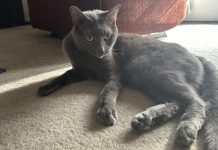UW Health Anesthesiology resident Nyle Larson, proper, discusses induction of anesthesia in an equine affected person with members of the UW Veterinary Care scientific workforce throughout a weeklong elective within the hospital. © University of Wisconsin-Madison School of Veterinary Medicine
Carrie Schroeder, part head of Anesthesiology on the University of Wisconsin-Madison School of Veterinary Medicine, desires clinicians in each human and veterinary medication to know they maintain much more in frequent than they may suppose. An elective on the SVM for doctor residents of UW Health helps make that potential.
The program, coordinated and formalized by Schroeder, permits human medication anesthesiology residents to spend per week at UW Veterinary Care to realize a brand new perspective in a distinct line of follow. The trade occurs round eight occasions a yr, however Schroeder expects additional enlargement.
As this system has developed, so have alternatives for SVM trainees. UW Veterinary Care residents are actually invited to UW Health Anesthesiology rounds (shows of a scientific situation). Coordinators are additionally exploring alternatives for veterinary residents to rotate by the human hospital, in addition to potential analysis partnerships.
During the week they go to UW Veterinary Care, every UW Health resident has flexibility on what varieties of instances they observe and examine. Nyle Larson, a current resident participant, had the chance to be taught from sufferers ranging in measurement from a small snake to a 1600-pound horse.
“I think the horse anesthetic was the most intense induction I saw while at the vet school and the most physically demanding that I’ve ever seen — humans or animals,” he says.
“From a recruitment standpoint, it’s been huge. I think we’re the only program in the country that offers an experience like this. A lot of students are drawn to us because of their interest in getting that experience.”
Larson discovered of the elective from program alumni, who praised it, and he desires to proceed the custom of recommending it to potential UW Health residents. He famous the rotation as a singular characteristic when interviewing for residencies 4 years in the past.
Christopher Darling, affiliate professor and residency program director within the UW Health Department of Anesthesiology, confirms these sentiments. “From a recruitment standpoint, it’s been huge,” he says. “I think we’re the only program in the country that offers an experience like this. It’s one of the big things we’re asked about on recruitment days. A lot of students are drawn to us because of their interest in getting that experience.”
For Schroeder, the chance to facilitate and information this system towards success has been rewarding. “Our jobs are very similar in veterinary and human medicine,” she says. “The elective provides low-stakes learning for visiting residents. They can learn for the sake of learning and appreciate what they do for anesthesia, how we do it a bit differently, and how the art of anesthesia is similar just with different species.”
Ultimately, the pairing encompasses the “one health” concept: optimum well being outcomes are achieved when individuals work collectively and acknowledge the interconnectedness of people, animals, and the shared surroundings.
“It was eye-opening to see how the physiology of animals compared to humans,” Larson says. “Also surprising was that a lot of the medicines we use are identical to medicine veterinarians use, even down to the doses.”
» Article courtesy of the University of Wisconsin-Madison School of Veterinary Medicine. It first appeared in the summertime 2022 situation of On Call journal.









































